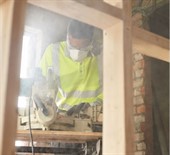Evidence on occupational exposure to wood dusts

The Challenge
There is a significant burden of serious respiratory disease
associated with wood dust exposures in British industry. This
disease is largely preventable through the adoption of good
exposure control practice. HSE scientists aimed to provide a
clearer understanding of how well dust exposure is being controlled
in high-risk industrial sectors.
The Solution
HSE's occupational hygienists visited 22 woodworking companies
in the manufacturing sector, the majority of which were small- and
medium-sized enterprises, to assess dust exposures and the
associated control strategies. Data from these visits was combined
with information from HSE's extensive library of occupational
hygiene reports to provide further insights. This included a focus
on cleaning activities, which are known to make a significant
contribution to overall exposures.
Airborne dust present during construction activities comes from
a range of different sources. A new analytical method was developed
to provide a better understanding of wood dust exposures in the
construction industry, where it is only one component of the total
airborne dust. Information from this new method has provided
valuable evidence supporting our understanding of wood dust
exposures in the construction sector.
The Outcome
This work has delivered:
- information allowing HSE to conduct an evidence-based
assessment of the impact of a new, reduced wood dust workplace
exposure limit
- exposure control benchmarks to underpin inspection
activities
- a new analytical assay which will facilitate a clearer
understanding of respiratory exposure globally in the construction
sector.
For more information see our Complete Worker Health
pages.
This case study was featured on page 28 of the HSE Annual Science Review 2020.
For more information contact us by
email or using the enquiry
form.
Back to the top